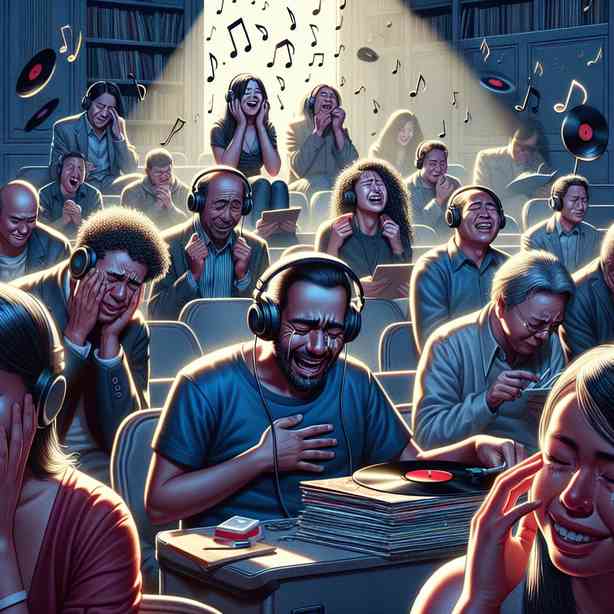
Music has an extraordinary power to evoke emotions, and one of the most profound reactions we experience is crying, particularly in response to certain songs. This phenomenon is not just limited to sad melodies; it encompasses a wide range of emotional responses that reveal the intricate connection between music and human feelings. Understanding why we cry during specific songs involves exploring the psychological, biological, and social dimensions of music.
At the heart of this emotional response is the brain’s intricate wiring. When we listen to music, various regions of our brain are activated, including those involved in emotion regulation, memory, and even bodily sensations. The amygdala, responsible for processing emotions, plays a pivotal role in how we react to music. When a song strikes a deep chord within us, it can trigger a release of neurotransmitters such as dopamine, which are often associated with pleasure and reward. However, alongside this rush of joy, certain musical elements can also tap into our memories and life experiences, leading to tears.
The memories we associate with songs can significantly influence our emotional response. A familiar tune may remind us of a cherished moment or a significant life event, drowning us in nostalgia. For instance, a song played during a memorable occasion, such as a wedding or a graduation, can evoke strong emotions when revisited. This is especially true when the lyrics contain themes of love, loss, or longing, which resonate with personal experiences. Therefore, crying during a song can be a manifestation of these complex associations as we navigate through our memories.
Furthermore, the lyrics of a song can significantly enhance our emotional response. A well-crafted lyric that articulates feelings we may struggle to express ourselves can stir a powerful reaction. For instance, songs that deal with heartbreak, longing, or existential angst can resonate deeply with listeners, leading to tears. The sense of validation that comes from hearing our feelings mirrored in art can be immensely cathartic. This connection to the lyrics allows us to explore our vulnerabilities safely, with music serving as a vessel for emotional expression.
In addition to personal experiences and lyrical content, the musical elements themselves play a vital role in eliciting tears. Elements such as harmony, melody, tempo, and dynamics can create a sonic landscape that intensifies our emotional response. For instance, a slow tempo combined with a minor key can evoke feelings of sadness, while a sudden shift in dynamics or a haunting melody can create a profound sense of longing. These musical techniques are not merely artistic choices; they are scientifically proven methods to evoke specific emotions.
Crying while listening to music can also be understood through a biological lens. The release of tears is a physiological response that can be triggered by intense emotions. Emotional tears contain higher levels of stress hormones and other chemicals than tears produced from irritation. This suggests that crying can serve as a form of emotional release, helping to alleviate emotional pain and stress. When we listen to music that resonates with our current emotional state, it may lead to the release of pent-up feelings, resulting in tears. This physical response underscores the intertwined relationship between our body and mind when we encounter powerful artistic experiences.
Moreover, the act of crying can facilitate a sense of connection with others. In a shared musical experience, whether it be at a concert or simply listening to a favorite song with friends, we may find solace in our emotional vulnerability. It reminds us that we are not alone in our feelings; others too experience moments of sadness or joy triggered by music. This social aspect of crying during songs emphasizes the communal nature of music and its ability to foster empathy and understanding among individuals.
Another interesting facet of this emotional reaction involves the concept of empathy. When we engage with music, we often empathize with the feelings expressed by the artist. This emotional engagement goes beyond mere appreciation of the melody or the lyrics; it allows us to view the world through another’s lens. We might cry not only because the song resonates with our personal experiences but also because we feel for the artist’s experiences, stories, or emotions. This dual pathway of empathy expands our emotional responses, making music a poignant tool for emotional exploration.
It’s essential to acknowledge that not everyone responds to music in the same way. Individual differences, such as personality traits, cultural background, and life experiences, can significantly influence how we relate to music on an emotional level. Some individuals may be more predisposed to emotional responses due to their temperament or past experiences. For instance, people who score high in openness to experience tend to be more emotionally responsive to music, indicating that personality plays a vital role in how we process emotional stimuli.
In conclusion, the act of crying during certain songs encapsulates a complex interplay of psychological, biological, and social factors. From the brain’s emotional pathways to the personal memories we associate with melodies, each aspect contributes to this profound reaction. Understanding why we cry when listening to music invites us to explore the deeper layers of our emotional experiences, allowing us to embrace our vulnerabilities and connect with ourselves and others through the universal language of music.
As we navigate the emotional terrain that music presents, it’s crucial to appreciate the richness of the experience. Each tear shed while listening to a poignant song is a testament to our humanity and the unique ways we resonate with art. Music becomes more than just sound; it transforms into a companion for our journey through life’s ups and downs. So next time a song moves you to tears, take a moment to reflect on the layers of emotion at play, for within those tears lies the beauty of connection—both with ourselves and with the world around us.


